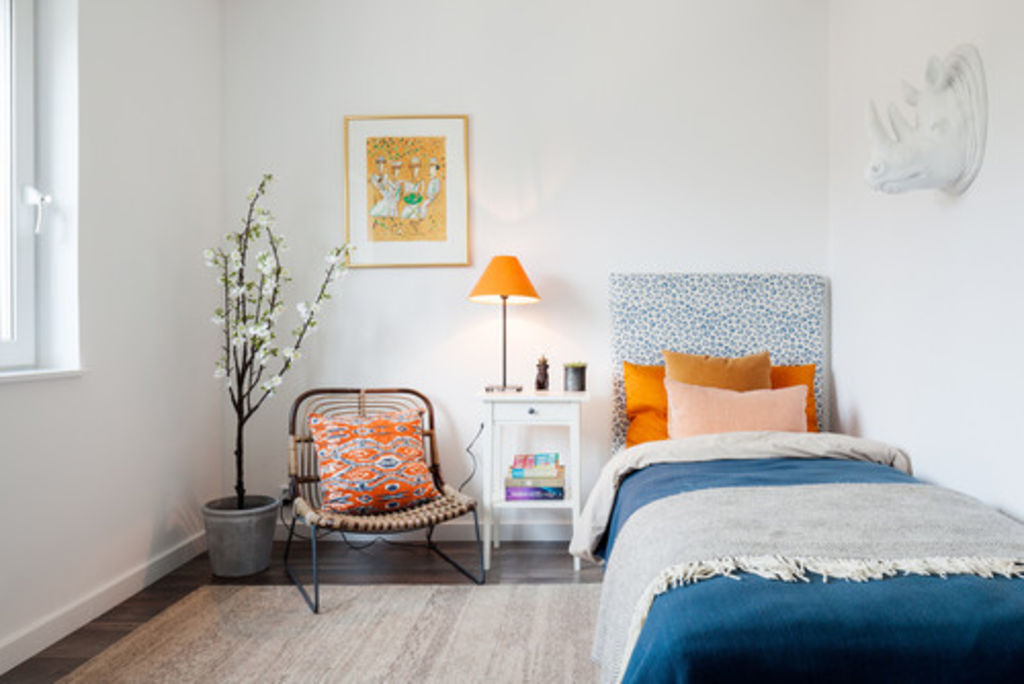What I learned when I moved a loved one to a retirement home

Author: Janet Dunn on Houzz
There are plenty of cheerful quips and sage advice for those facing old age. They are urged to stay “young at heart” and “age gracefully”, and told that “eighty is the new sixty”. Women’s rights activist Betty Friedan suggested that “ageing is not lost youth but a new stage of opportunity and strength.”
On the other hand, actress Bette Davis wryly noted that “old age is not for sissies.” As I see my once active and fun-loving mother-in-law struggle to manage her own safety and wellbeing, I think I’m with Bette.
Val will shortly move to an aged-care village and the family is working towards a, hopefully smooth, transition from self-reliance to dependency. I gladly agreed to oversee furnishing her future home, a one-bedroom unit in the complex.
This story shares what I learnt about decorating for those needing help with the challenges of growing old. Invaluable guidance on aged care environments came from the Victorian Government’s Health Vic advisory body.

Change hats
It’s easy when decorating for someone else to assume they’ll like what you like. I had to step into the shoes of this beautiful 92-year-old woman (seen here at 84), still mobile but with some health complications and perceptual difficulties.
What I did: I thought about Val – her early life, her personality, her relationships, what she liked to do, how she might react to her new home. She is familiar with a different era of design than I am, and trendy modern decor would mean very little to her. I wanted to create a functional, safe and serene place she could call home
This is a project-in-waiting as Val’s unit is not yet available. These images illustrate the principles I applied when planning the design.
Choose colours for comfort and personality
Emotional responses to colours significantly affect our moods and comfort. In the elderly, they also aid with navigation and orientation.
What I did: I talked to The Colour Agency’s Jacquelene Symond, an interior designer who has studied colour psychology. She has worked with Southern Cross Care and had helpful tips on colours for elderly eyes.
Take greyed-off colours out of the picture, she advises. “You can still use blues and soft colours, but in clearer, more distinct, tones. Greens with a yellow tinge work well. Contrasts are important in differentiating items, but lots of stark white is hard on eyes and increases production of cortisol, the stress hormone.”

Symonds stresses the importance of considering who you are designing for, and if possible involving them in choices. Val is a gentle feminine soul – her palette is pinks, pastels, pale lavenders and blues. To avoid low-contrast, washed-out colours, I compromised by boosting the mood with warm sunny peach and fresh cool turquoise accents.
Double-check dimensions
Overall area and room dimensions affect furniture size, style and placement, colours, pattern choices and how functions fit into a space. Doors, windows and power outlets also dictate furniture layout.
What I did: I drew up a floor plan and took it shopping. The unit’s total area is about 19 square metres, with a small terrace off the bedroom and living space, a bathroom and kitchenette. I needed compact furniture and only pieces that were absolutely necessary in order to keep the traffic paths between rooms and to the outside open.

Prioritise important furniture
Deciding on what Val would use most was easy. She’s an avid reader and a bit of a couch potato, so I put a chunk of my budget into a quality sofa. Upright sofas with timber arms were out, curves and comfort were in.
What I did: Elderly joints protest at levering themselves up from deep squashy sofas or perching on a too-firm seat. I chose this 2.5-seater Tivoli sofa from UD Furniture, which straddles the line between modern and traditional, and had it custom-upholstered for a quieter look. It features rolled arms, high back cushions, and a supportive high-density filling.
Steal space
The bedroom was a challenge, at just 2.9 metres wide and with limited solid walls. It was essential to maximise open space to make night-time loo trips as safe as possible.
What I did: Changing from a queen to a double bed bought precious space. Having just one bedside table with roomy storage leaves access to the bathroom clear.
A sofa doesn’t always need a coffee table. In this case, one would narrow access to the terrace. I found curvy timber nesting tables that are light, easy to move, and the kidney shape tucks neatly up against furniture corners.
Sharp corners and glass are hazards. Everything to go into Val’s home is rounded and curved. If angular furniture is used, plastic corner shields protect sharp edges.
Cater for habits
Personal routines are important for the elderly, helping them maintain a sense of order and control in their daily lives.
What I did: Pretty and feminine at 92, Val wanted a dressing table and chair so she could sit and put her make-up on. Ikea came up with a neat unit just 70 x 42 centimetres with a fold-up mirror and red felt-lined compartments for make-up underneath. A chair with padded seat and back support tucks snugly underneath.
Enhance tea time
Although the complex has a pleasant social dining room, an inviting dining setting would come in handy for visiting guests and family.
What I did: Again, it was curves not angles with a neat table with rounded corners against a wall. Stable padded chairs with legs within the seat profile, easily moved out from the table, are essential. Ensure the table top contrasts with the floor and the chairs, to help depth perception. A bright cloth helps to clarify edges.
Make an entrance
Every home, no matter how small, should have a welcoming entrance with a place to drop keys, sunglasses, bags and shopping.
What I did: The entry hall is fairly tight, but a narrow console with a drawer is enough to hold some pretty objects – flowers and a couple of framed family photos. It still allows wheelchair access if it becomes necessary.

Go lightly
Of all design factors, lighting has the greatest impact on wellbeing. It aids orientation, way-finding and mood, and can prevent falls. Older people need three times as much light as younger ones to perceive true colours and they are hyper-sensitive to glare. A combination of natural and artificial light, indirect glare-free general light and task lighting is desirable – and no flickering fluorescent.
What I did: I boosted existing overhead lighting with easy to-operate lamps and warm white light output. The unit receives plenty of daylight, so lacy sheers filter it without darkening the room.
Reconsider rugs
Val had already fallen a couple of times in her previous home, so I was keen to exclude anything that might cause another one.
What I did: I was reluctant to give up the acoustic benefits and homey textural qualities of a foot-friendly rug. However, a darker rug on a light carpet may be perceived as an alarming hole and is a potential trip danger, so sadly rugs and mats are out.

Hang meaningful artwork
Abstract art in vivid clashing colours isn’t optically comfortable. Artwork that represents reality – a country or garden scene, people, flowers and animals – will have more meaning and may trigger pleasant thoughts.
What I did: I always associate Val with pretty flowers and she’s an inveterate bird feeder. I picked canvas prints with butterflies, birds and beautiful blooms in clear blues, pinks, peaches and greens. We’ve often holidayed together at the beach, so a beach scene was a must.
Use patterns with care
Big busy patterns such as wide stripes and zig-zagging geometrics may create perplexing optical illusions. Dark spots and circles are a particular problem as they can resemble holes or dirty marks to ageing eyes and less-than-acute senses.
What I did: I kept patterns to a minimum and used them where they would visually define items and areas. I’m thinking a touch of gingham or paisley would add a familiar element.

Pile on textures
Touch is a strong sensory influence for the elderly, especially with fading vision and borderline dementia. It aids with recognising items, negotiating furniture and stimulating memories.
What I did: I contrasted soft pure wool and fleecy throws for the sofa, armchair and bed, velvety cushions, embroidered fabrics and tactile linen with supple leather, crisp cottons and smooth timber surfaces.
Include memory triggers
A completely unfamiliar environment can be daunting, and not only for the elderly. I was a little concerned the unit would look too different to Val’s previous home, but felt that her existing furniture would create space issues in the unit.
What I did: I collected a selection of small recognisable items, collated for their personal significance and to keep clutter to a minimum. I made a collage of family photos and framed some for prominent spots in the entrance, bedroom and living space. A family photo on Val’s door will aid with identifying “home”.
Val has a collection of pretty, old-fashioned china – she is from the era when tea was sipped from delicate bone china cups with saucers. Some will find a place in the kitchenette handy to tea-making equipment and some will brighten up a sideboard.
Connect with nature
A 2016 Natural England commissioned report, Is It Nice Outside? lists the many benefits of engagement with nature during various stages of dementia. These include a more positive emotional state, less stress, reduced agitation and apathy, and better sleep, appetite, attention, awareness and sense of belonging.
What I did: Placing furniture with maximum exposure to outdoors helps prevent a feeling of isolation that can depress elderly people. The terrace off the living area will be a mini-garden of familiar old-world plants, with some indoors too. Small tasks such as nurturing plants generate a sense of purpose and usefulness.
Don’t forget sounds
The acoustic environment affects how we function. People with ageing senses need to comprehend it by clearly identifying sounds and their sources. It’s essential to reduce uncomfortable noises and auditory clutter.
What I did: Plenty of soft surfaces and fabrics absorb sound and I’ve ensured that music would be part of Val’s day, with a radio with manual controls – digital controls cause confusion in older age groups.
Subtle scents
Although over-stimulation is distressing, gentle sensory reminders can have positive effects. The right scent is a powerful tool for triggering past experiences.
What I did: The final touch – and a pleasant task – was to find ways to scent Val’s new home. Naked candle flames and aerosol room sprays were out so I went sniffing for reed diffusers. I chose subtle old-fashioned florals, gardenia and wild jasmine with a hint of mint. I hope they’ll spark comforting memories of Val’s younger days and flowers that she loved.
We recommend
States
Capital Cities
Capital Cities - Rentals
Popular Areas
Allhomes
More
- © 2025, CoStar Group Inc.







